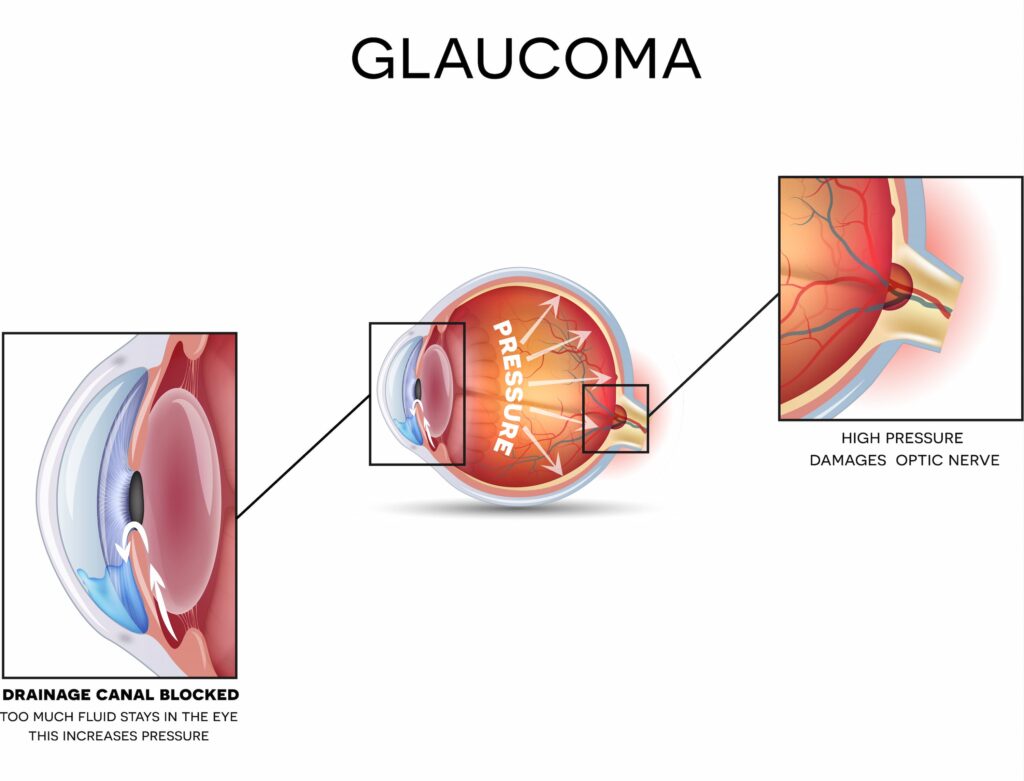
Glaucoma is a disease of the optic nerve, which is the part of the eye that carries the images we see from the eye to the brain. The optic nerve is made up of many nerve fibers (like an electrical cable containing numerous wires). Glaucoma damages nerve fibers, which can cause blind spots in our vision.
Glaucoma is associated with pressure inside the eye or intraocular pressure (IOP). When the clear liquid called the aqueous humor, which normally flows in and out of the eye, cannot drain properly, pressure builds up in the eye. The resulting increase in IOP can damage the optic nerve. Dr. Greenberg may tell you that you are at risk for glaucoma if you have one or more risk factors, including an elevated IOP, family history of glaucoma, a particular ethnic background, advanced age, or a certain optic nerve shape.
If you are at risk for glaucoma, regular eye examinations and specialized testing including visual fields, Optical Coherence Tomography (OCT), disc photographs, gonioscopy (measurement of the drainage pathway of fluid), and pachymetry (measurement of corneal thickness) are important methods in detecting the earliest signs of change, helping to preserve your vision.

The most common form of glaucoma is primary open-angle glaucoma, where the aqueous fluid that normally circulates in the front portion of the eye is blocked from flowing out of the eye through the drainage system. This causes the pressure inside your eye to increase, which can damage the optic nerve and lead to vision loss. Most people who develop primary open-angle glaucoma notice no symptoms until their vision is impaired.
Treatments
Glaucoma can be treated in several ways, including topical eye medications, oral medications, or laser treatments to lower the intraocular pressure of the eye. There are also surgical techniques if the aforementioned treatments fail.
The SLT (selective laser trabeculoplasty) laser is a “cold laser” that when focused on the drainage area of the eye, enables the fluid to drain more effectively. It is “selective” in that only pigmented tissue in the drainage pathway will uptake the laser, causing less collateral damage of scarring and pain than former heat-based lasers. Data shows that this laser can lower IOP by 30% as initial therapy and can be repeated if necessary. The procedure is performed in two stages to prevent eye pressure from temporarily spiking. We can perform this procedure in our office.
Surgical Treatments for Glaucoma
Glaucoma is caused by a build up of fluid inside the eye which then damages the optic nerve.
This buildup of fluid can happen due to a block in the outflow pathway (trabecular meshwork), where fluid normally drains out of the eye to maintain normal intraocular pressure. Glaucoma has no early warning signs and left untreated, will cause permanent vision loss.
There is no cure for glaucoma, but fortunately there are surgical treatments available. The
following are two quick, painless, FDA approved, out-patient procedures that Dr. Greenberg
performs:
Kahook Dual Blade Goniotomy
The Kahook Dual Blade Goniotomy can be performed independently or at the time of cataract
surgery through the same microincision. Dr. Greenberg uses the Kahook Dual Blade, a single-
use instrument, in conjunction with a special mirrored lens to make parallel incisions in the
trabecular meshwork improving the outflow of fluid reducing the intraocular pressure in the
eye.
iStent Inject W
At the time of cataract surgery, Dr. Greenberg performs the iStent Inject W procedure where
she implants two stents in the trabecular meshwork to improve the outflow of fluid in the eye
lowering the intraocular pressure. This stent is the world’s smallest implantable
device (1/3 the size of a grain of rice). You will not see or feel the implants.
If these procedures are successful, you may be able to discontinue one or more of your glaucoma medications.
Glaucoma FAQs
What is the visual expectancy of a person with glaucoma?
Glaucoma is a chronic eye disease that, if left untreated, can lead to vision loss. However, with proper management and treatment by Dr. Dana Greenberg, the progression of glaucoma can often be slowed or halted.
What is the real root cause of glaucoma?
The primary cause of glaucoma is elevated intraocular pressure (IOP), which can lead to damage of the optic nerve. Other factors such as genetics, age, and certain medical conditions may also contribute.
What can be mistaken for glaucoma?
A condition that can be mistaken for glaucoma is normal age-related changes in vision. A comprehensive eye examination by an ophthalmologist, such as Dr. Dana Greenberg, is essential for an accurate diagnosis.






